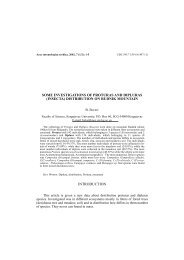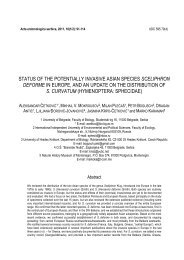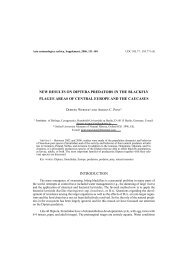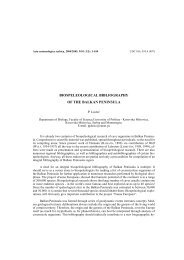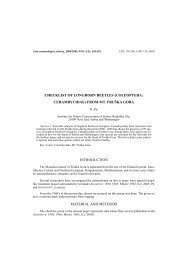Kollar, J. & Hrubik, P: The mining species
Kollar, J. & Hrubik, P: The mining species
Kollar, J. & Hrubik, P: The mining species
You also want an ePaper? Increase the reach of your titles
YUMPU automatically turns print PDFs into web optimized ePapers that Google loves.
84<br />
J. KOLLÁR & P. HRUBIK<br />
damage types as well. On woody plants which grow in non-forest environments, the most significant damage<br />
(surface feeds, mines, skeletation, deflection, distortion or gall forming, etc.) (GREGOROVÁ, 2006) is suffered by<br />
various leaves, buds, shoots and wood.<br />
In this paper we have dealt with insect pest groups which cause mines on leaves, shoots, and eventually on<br />
other parts of woody plant bodies. According to the record, the first mines made by lepidopterans appeared in<br />
late Jurassic, ca. 150 millions years ago. <strong>The</strong>ir number showed a steep increase in the Cretaceous, probably<br />
correlated with the radiation of angiosperms. In the last few decades leaf miners have become popular study<br />
organisms. Several ecological and evolutionary hypotheses have been tested on them, the attention spent on<br />
them exceeding their economical importance. <strong>The</strong> evolutionary success of leaf <strong>mining</strong> insects is proven by<br />
their large numbers, and by the fact that leaf <strong>mining</strong> <strong>species</strong> can be found in several orders. According to<br />
present knowledge, ca. 10,000 <strong>species</strong> of leaf <strong>mining</strong> insects have been described so far. <strong>The</strong>se insects<br />
belong to ca 50 families from 4 orders (Coleoptera, Hymenoptera, Diptera and Lepidoptera) (CSÓKA, 2003).<br />
STOLINA et al. (1985) defined <strong>mining</strong> as feeding inner tissues and needles, without damaging epidermis. Mines<br />
can be created by caterpillars, beetle larvae, hymenopteran and dipteran insects. Mines are always created<br />
only by insect larvae (STOLINA et al., 1985). Leaf mines vary considerably in shape and size, and can therefore<br />
be classified in many different ways. Mines can be serpentine and blotchy. Serpentine mines develop if<br />
larvae feed step by step in one direction. Blotchy mine forms if larvae turn during feeding (CSÓKA, 2003).<br />
Mining insects are the second most prevalent group of insects in urban greenery. If they don’t occur in large<br />
numbers, they don’t cause serious damage to host plants (HRUBÍK, 1988). WINIARSKA (1979) discovered that<br />
along with the composition of woody plants <strong>species</strong>, the number of <strong>mining</strong> lepidopteran <strong>species</strong> in the urban<br />
environment is changing in dependence on urbanization degree.<br />
Materials and Methods<br />
From 2005 – 2008 terrain research was carried out in the selected cities of Nitra, Topoľčany, Komárno,<br />
Partizánske, Prievidza, Piešťany and Trnava. <strong>The</strong> aim of the research was to monitor <strong>mining</strong> insects, mainly<br />
on ornamental woody plants planted in urban environments. In the terrain, woody plant damage was<br />
controlled visually and from 2005-2008 samples of symptoms were collected three times per vegetation<br />
period in all localities. Eventually, some samples were collected to be reared in the laboratory and for<br />
determination. Some <strong>species</strong> were determined directly in the terrain. For the determination of mine samples<br />
on individual woody plant <strong>species</strong> we used the publications by LAŠTŮVKA & LAŠTŮVKA (1997), CSÓKA (2003) and<br />
SCHNAIDER (1976). <strong>The</strong> correct woody plant nomenclature is passed from publications ČERVENKA (1986) and<br />
(MARHOLD-HINDÁK, 1998).<br />
Results<br />
During the research we found 118 <strong>species</strong> of <strong>mining</strong> insects, belonging to 4 orders and 15 families. <strong>The</strong><br />
greatest number of <strong>species</strong> belonged to the Gracillariidae (38), Nepticulidae (25) and Agromyzidae (16) (Fig.<br />
1a) families. Lepidoptera (91) and Diptera (16) (Fig. 1b) orders were the most abundant.<br />
<strong>The</strong> following review (Tab. I) presents the list of found <strong>mining</strong> <strong>species</strong>. Species are classified according to<br />
individual orders, families and host plants. <strong>The</strong> non-indigenous <strong>species</strong> are marked by an asterisk.



